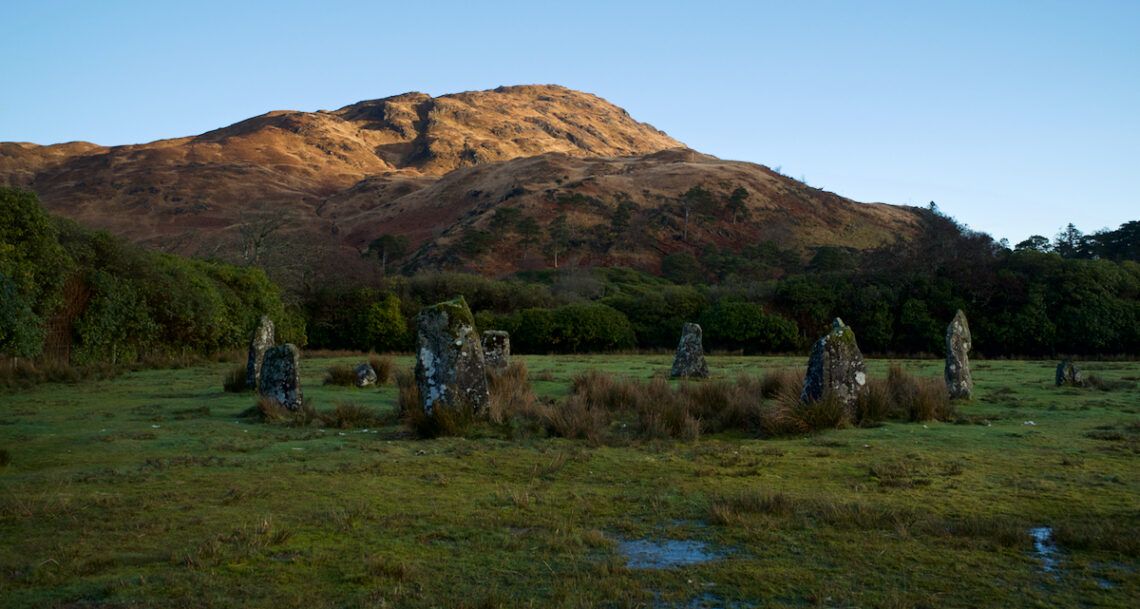
Lochbuie Stone Circle and Moy Castle, Isle of Mull
It’s not often that you get to see a sunrise over a stone circle on your birthday, especially when you weren’t really expecting it. Colin and I had booked the early ferry from Oban to Craignure, and with clear weather in prospect we were looking forward to spending a whole day on the Isle of Mull.
The forecast of dry weather seemed unduly optimistic when rain started to rattle against the windows on the way over. We rolled off the ferry while it was still getting light, and I wondered if we’d be needing waterproofs for the next six hours or so of daylight.
But I needn’t have worried. We headed south on the road that leads (eventually) to Fionnphort, but had to stop less than two minutes from Craignure because the sun was just rising over Loch Don and turning it into a sea of liquid fire. The sky was clearing and a sudden frost was coming down, turning any untreated road surfaces to sheet ice. The calls of waders – probably redshank, greenshank and curlews – floated up from the mudflats.
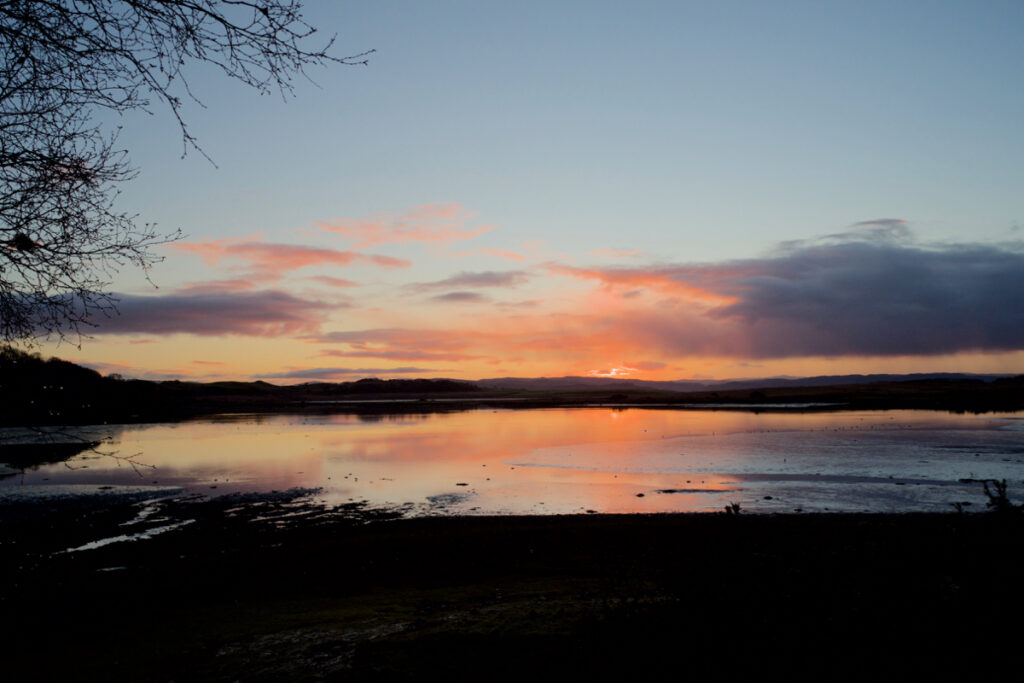
The road that follows the long, curving shore of Loch Spelve has to be taken at a crawling pace. For a start, it’s narrow with passing places; and the scenery is so amazing that you need time to take it in. A few solitary birds were out on the water, which were great northern divers in winter plumage, and we were lucky enough to watch an otter come out onto the shore. It was therefore quite a while before we arrived at Loch Buie, a shortish, broad sea loch rimmed with low hills.
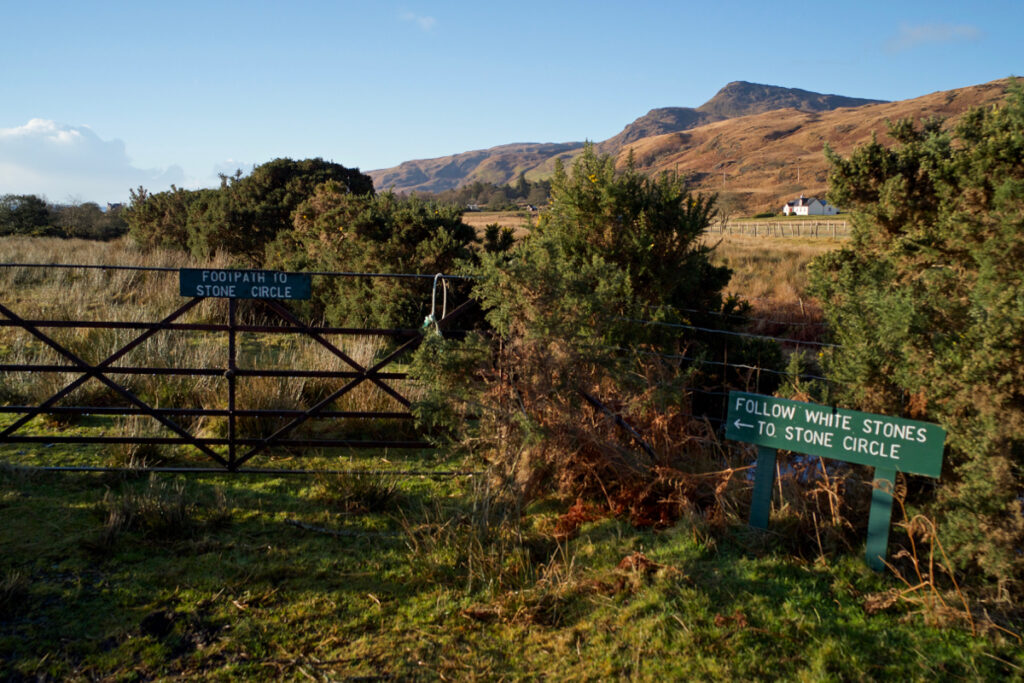
For a while I’ve known about the Lochbuie stone circle – one of the few stone circles on the west coast of Scotland – but somehow we’ve always passed by the road-end in our eagerness to get to places like Iona. Not so this time. We parked beside a bridge that spanned a fast-flowing burn, next to an encouraging sign that said ‘FOLLOW WHITE STONES TO STONE CIRCLE.’ This is the best kind of sign. The path led us past a couple of friendly and inquisitive Highland cows and through a field where a herd of fallow deer were browsing under some trees. (I’d no idea that there were fallow deer on Mull: they seem to have been introduced in the 1800s and I think they’re mostly confined to this area).
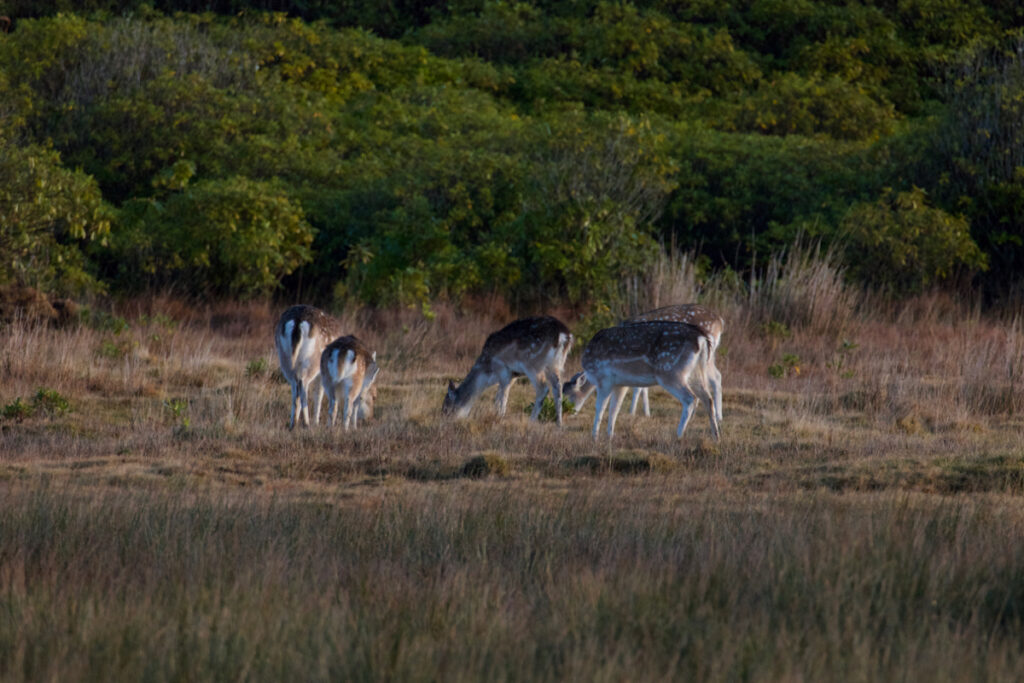
The ground got increasingly boggy, to the extent that if you stood still, water quickly engulfed the tops of your walking boots. About 10 or 15 white stones and an icy shower or two later, we passed through a gate into an open field and turned to see the stone circle at the far end, looking magnificent against a backdrop of gold-brown hills and old Scots pines.
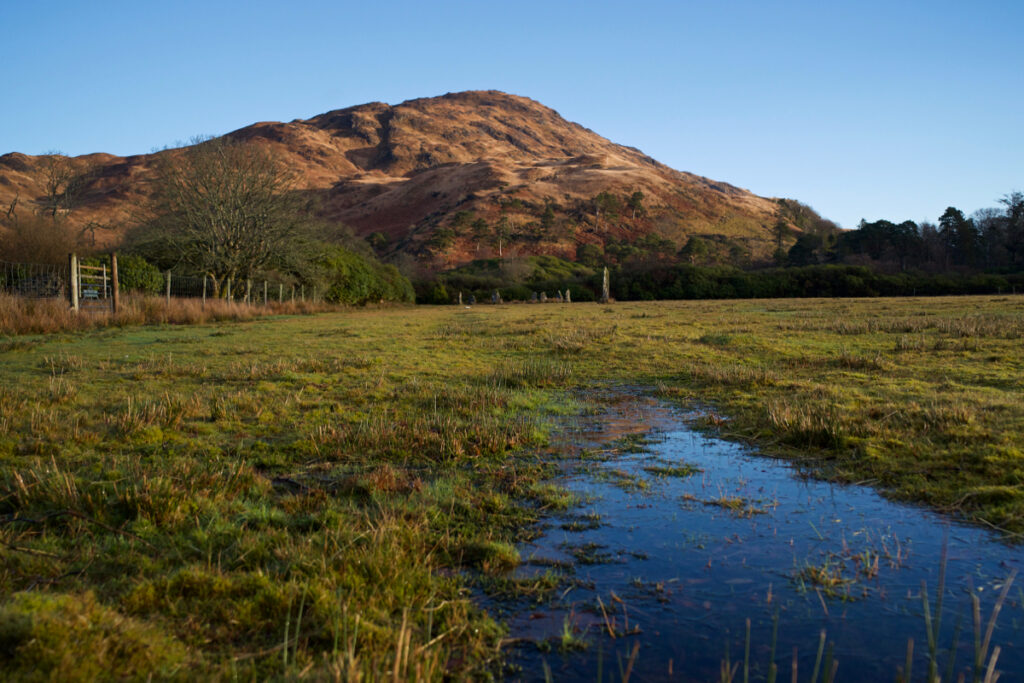
The Lochbuie stone circle isn’t huge – the tallest is about six and a half feet (two metres) in height, and the circle measures roughly 40 feet (12 metres) across. But it’s a really pleasing shape, describing an almost perfect circle of nine stones, one of which has been replaced in more recent times by a rounded boulder. The flattest sides of the stones face inwards, which gives a real sense of focus towards the centre. Each one is uniquely textured with moss and lichen, which of course are thriving in the damp climate.
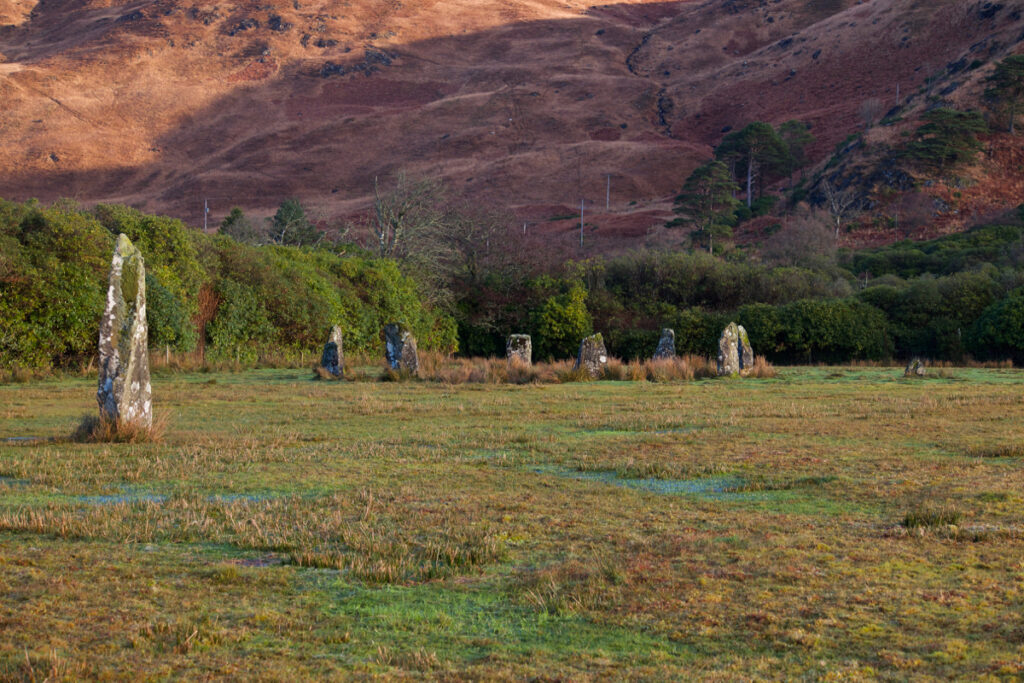
On the way to the circle, you pass two ‘outliers’ (above) both of which are taller than the stones in the circle itself. There’s a third, much shorter, just to the south-east.
Although I hadn’t fully realised it, the stones were still in shade when we arrived. All of a sudden, the sun burst over a hill to the south-east and everything was lit up, as if by a brilliant spotlight. The stones cast long slim shadows on the grass, now an intense green and topped with a frosty crust that wasn’t nearly hard enough to compact the ground.
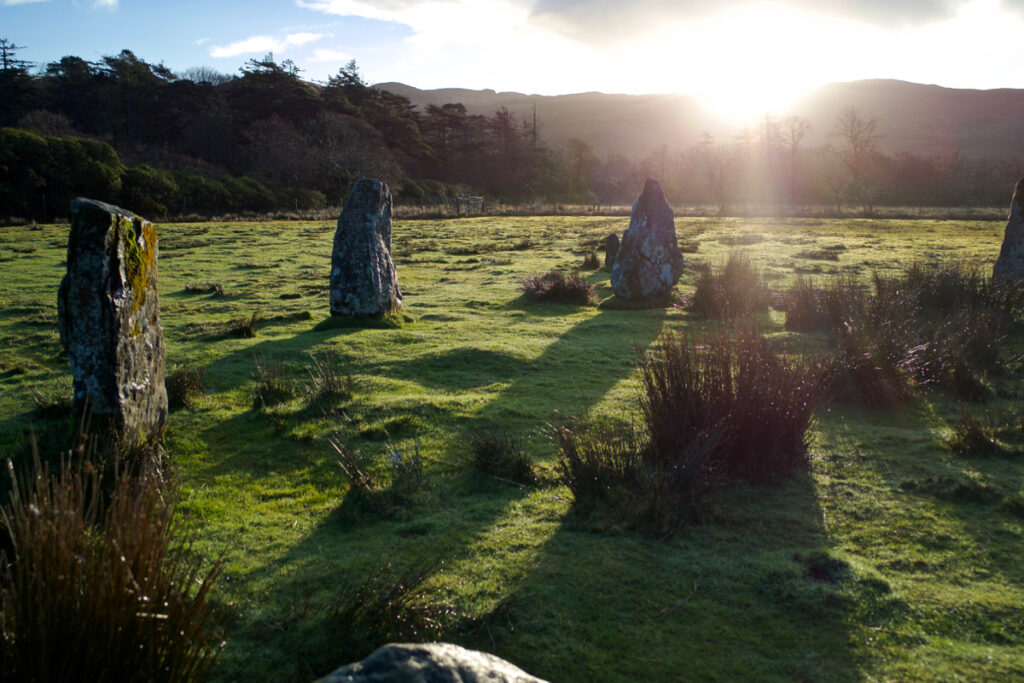
The moment of sunrise, or thereabouts
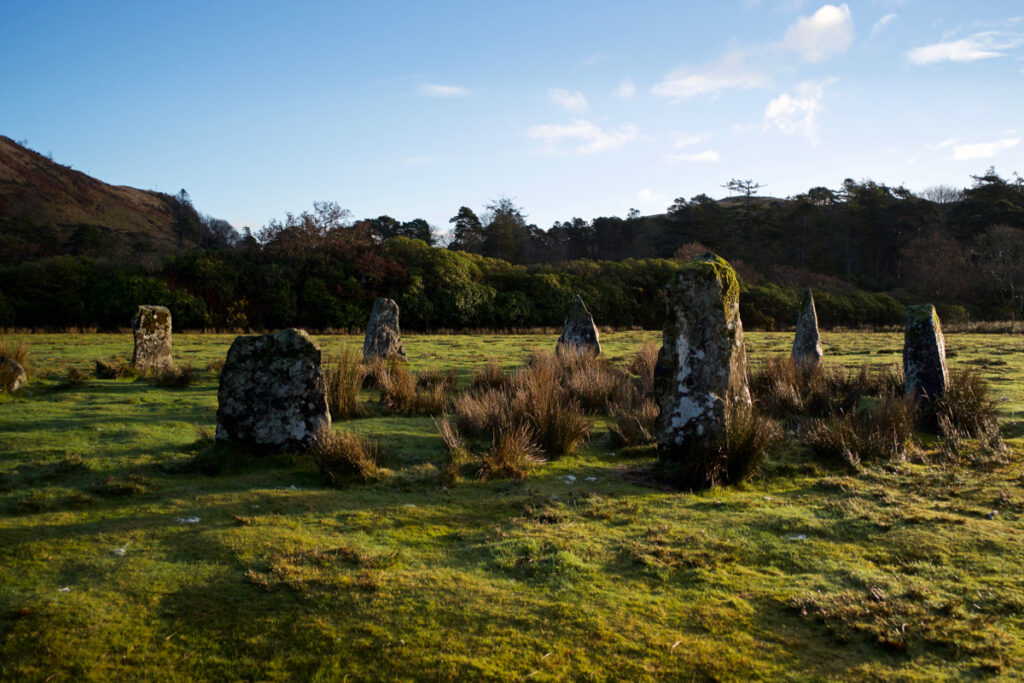
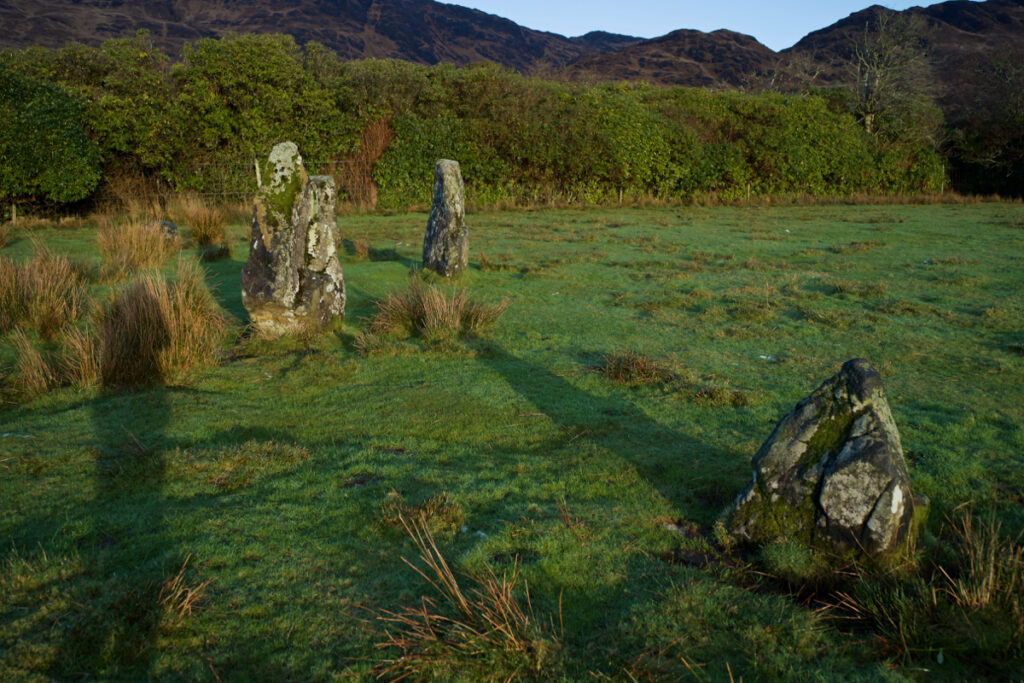
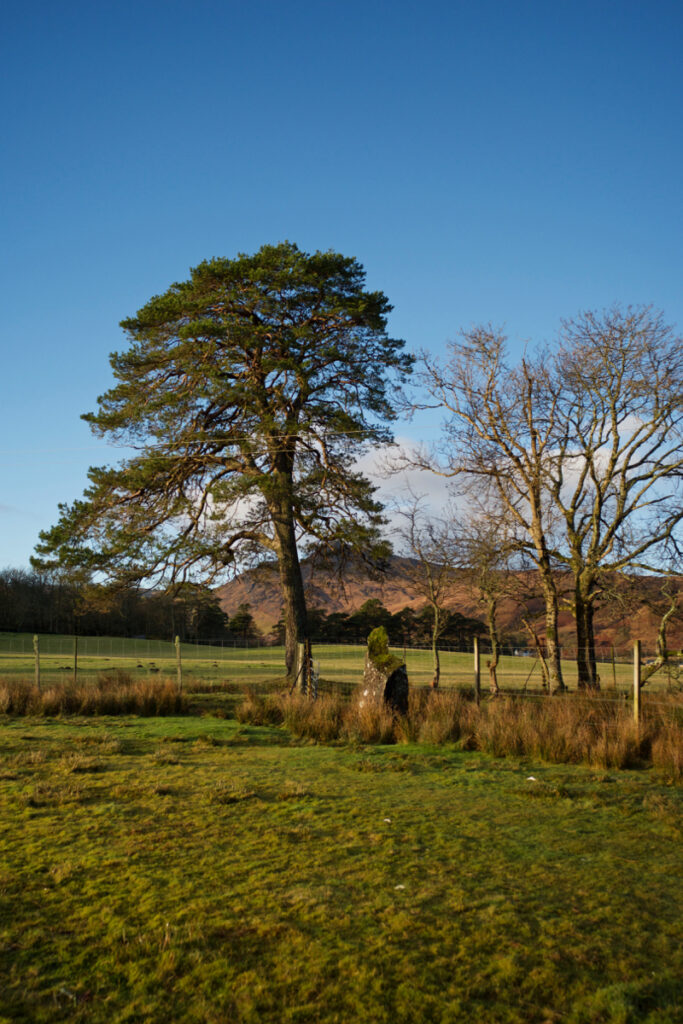 For the sake of dry feet we kept moving, looking at the circle from different angles, and then took our leave, past the ‘finger-post’ outlier by the gateway (which may have got its shape from a breakage long ago, although I don’t like to discount the idea of Neolithic or Bronze Age revellers staggering home and being thankful for a handy signpost).
For the sake of dry feet we kept moving, looking at the circle from different angles, and then took our leave, past the ‘finger-post’ outlier by the gateway (which may have got its shape from a breakage long ago, although I don’t like to discount the idea of Neolithic or Bronze Age revellers staggering home and being thankful for a handy signpost).
I’ve not come across any record of archaeological finds at Lochbuie stone circle. It is mentioned fairly briefly in The Stone Circles of the British Isles (1976) by Aubrey Burl, who says that it is ‘perhaps aligned on the midwinter sunset’ through the tallest outlier, and notes that it is situated ‘in a rare, cultivable patch of flat land.’ I don’t know whether I’d call it cultivable now. I’m guessing that the climate was drier at the time of its building.
The deer were moving into the woods, but we headed for the beach and walked along the shore towards Moy Castle, a 15th century tower house that was once a stronghold of the Maclaines of Lochbuie (or Lochbuy, an older spelling). The tide was out, and the boulders were slippery with ice and seaweed. Here and there, masses of yellow and orange periwinkle shells had been washed up and lay there gleaming like spilled treasure.
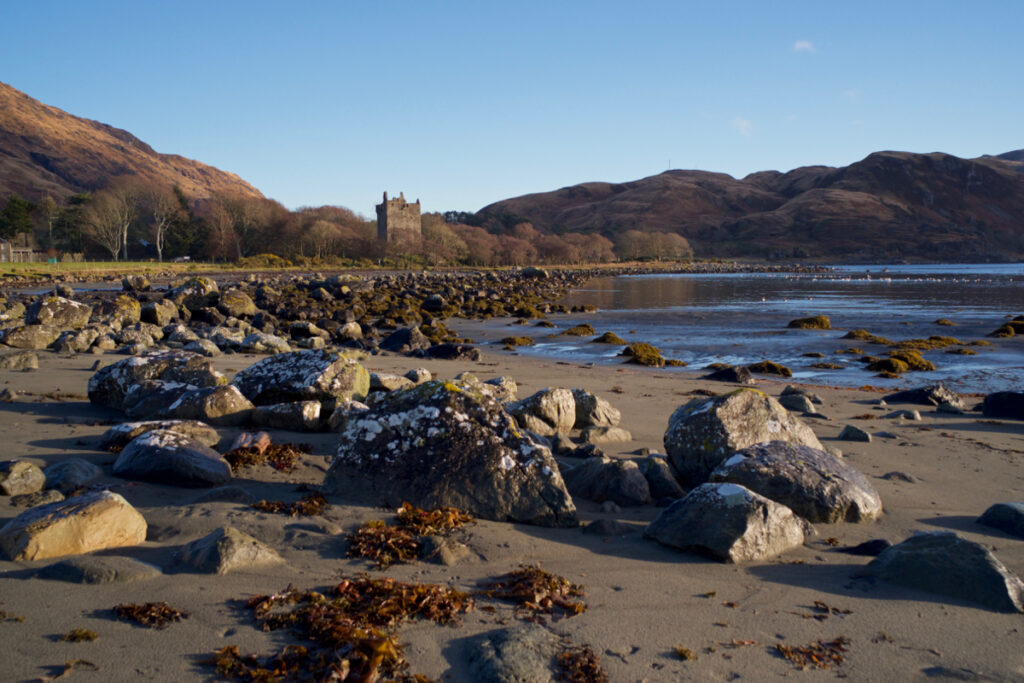
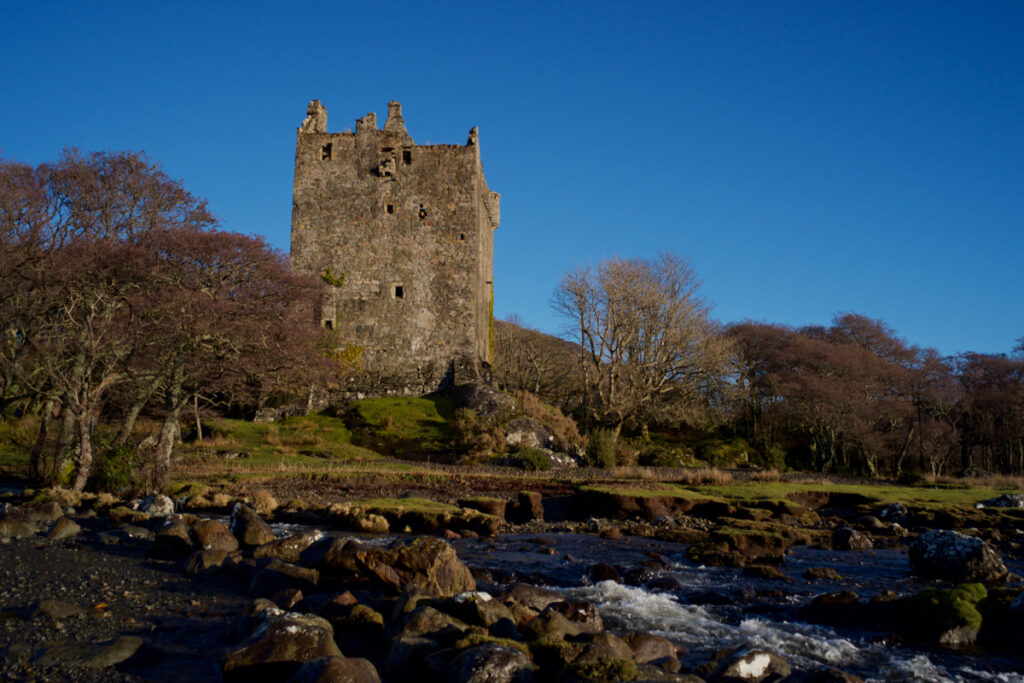
The building of Moy Castle is thought to have been begun by John, the 3rd Chief of Lochbuie, and completed by his son, Hector, the 4th Chief.
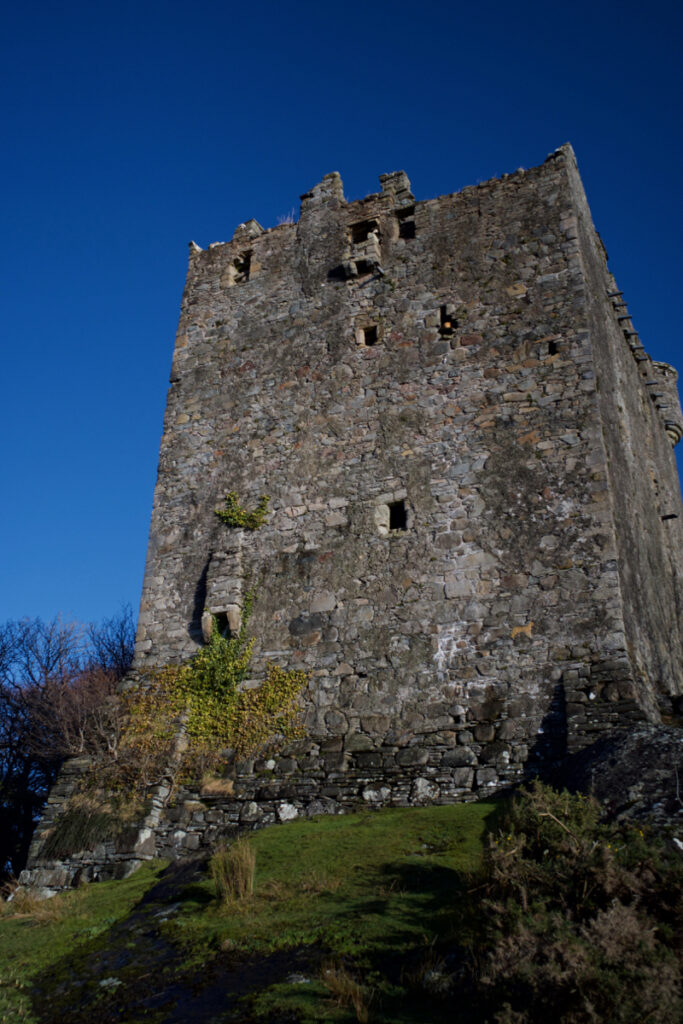
The castle stands just above the high water mark, on a rocky knoll surrounded by trees. An information sign told us that, in 1690, the Chief of Lochbuie was forced to surrender it to the Earl of Argyll because of his involvement in the Jacobite uprising of 1689, but it was restored to him in 1697. It had three floors with spiral stairs, a freshwater well, and a narrow ‘bottle dungeon’ over three metres deep. The Maclaines moved out to a newer house nearby in 1752, but apparently the Chief still threw offenders into his dungeon for many years thereafter.
We’d been hoping to get inside and even climb to the upper floors, but the entrance has been blocked off with a sign warning about dangerous masonry. From the outside, we could see a number of windows and openings, the wider ones with what looked like latrine chutes, and at the top a couple of turrets still stand at the corners of the parapet. According to the website of the Mull Historical & Archaeological Society, there have been several phases of restoration in recent decades, with some remaining work still to do.
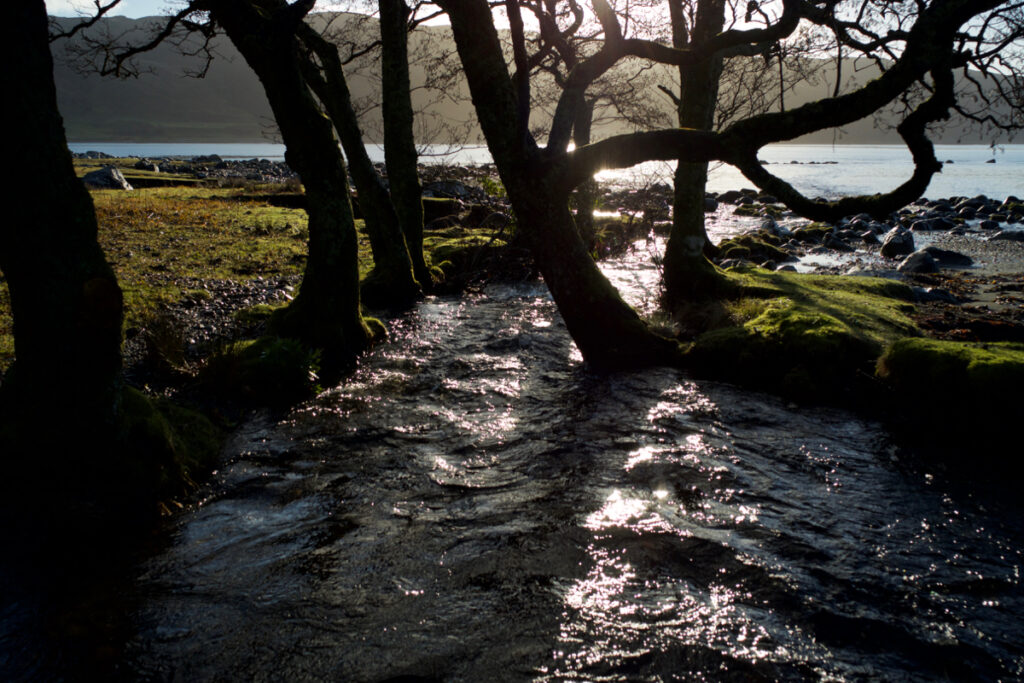
A burn flows right past the castle and out to sea. Clan Maclaine’s website says: ‘Still clearly visible between the Castle and the shoreline of Lochbuie loch are the original galley slips where the Clan would have hauled their galleys onto dry land.’
We took a winding route back to the car, crossing freshly exposed sands that sank beneath our feet. A couple of brief showers came and went, throwing rainbows against a slate-grey sky and leaving the tops of the hills sprinkled with snow. January isn’t always the best month for trips outdoors, but when the weather is just right you know full well that no day in summer, however hot and bright, can ever live up to this low lighting and the clarity of the air.
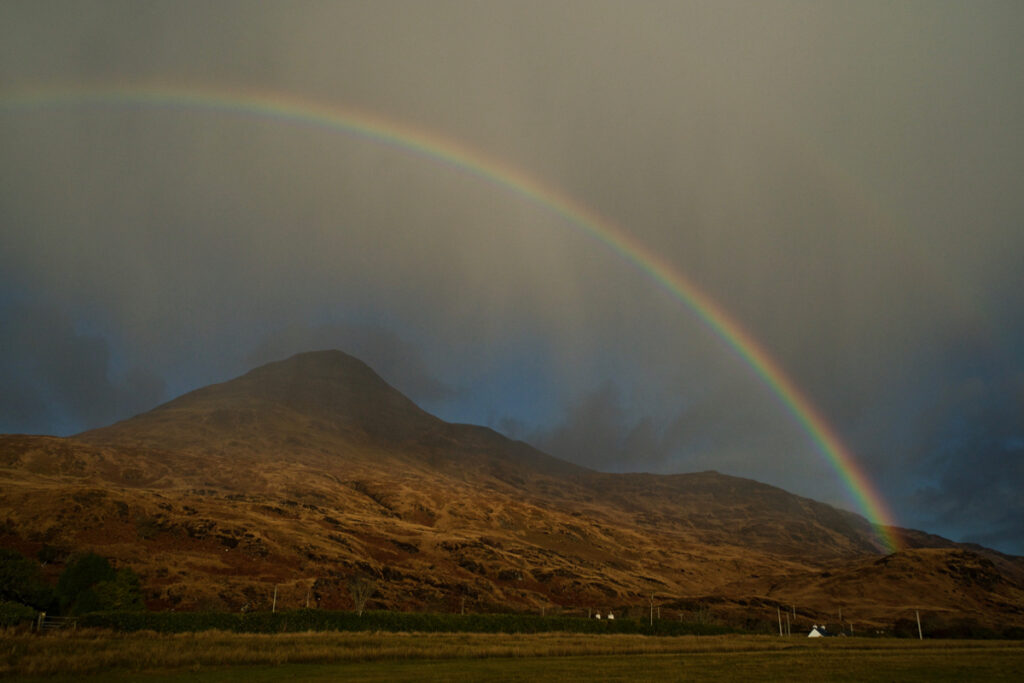
–
Out of interest, it was the Maclaines of Lochbuie who were involved in a notorious skirmish at Glengarrisdale on the Isle of Jura in 1647, when they were ambushed by the Campbells of Craignish. The skull of one of the Maclaines rested on a rock in the bay for many centuries thereafter. You can read more in these blog posts:
Reference:
- Mull Historical & Archaeological Society: Lochbuie Stone Circle and Moy Castle
- Clan Maclaine of Lochbuie
- Canmore: Lochbuie stone circle and Moy Castle
- Aubrey Burl, The Stone Circles of the British Isles (1976)
Photos copyright Colin & Jo Woolf



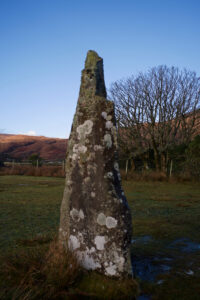
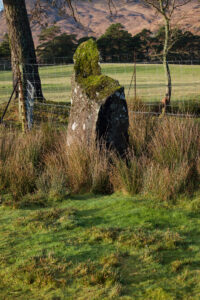
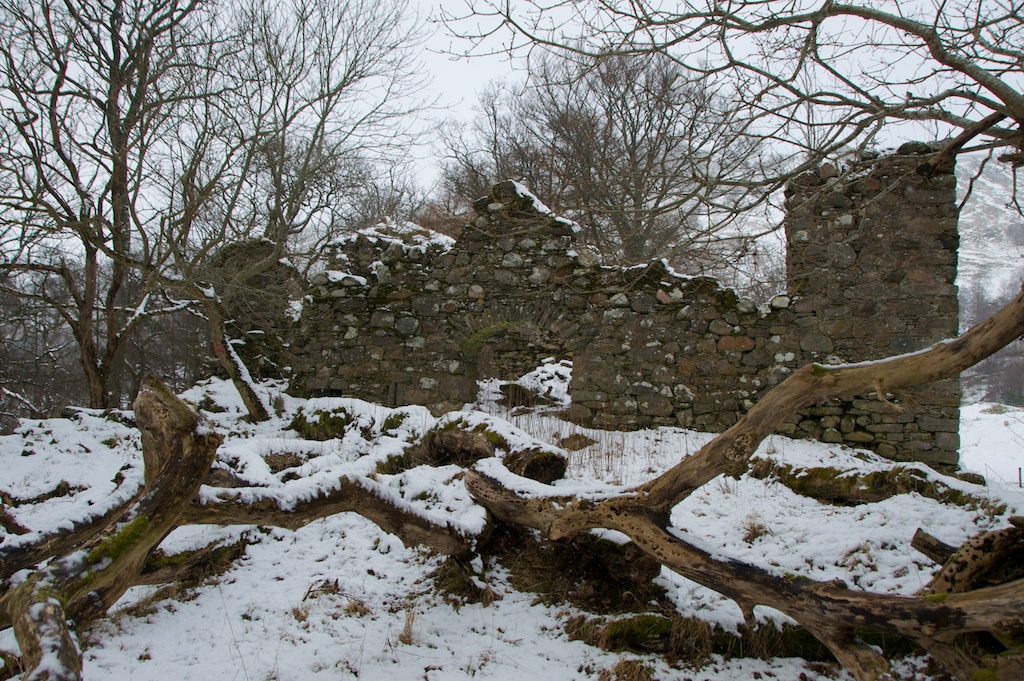
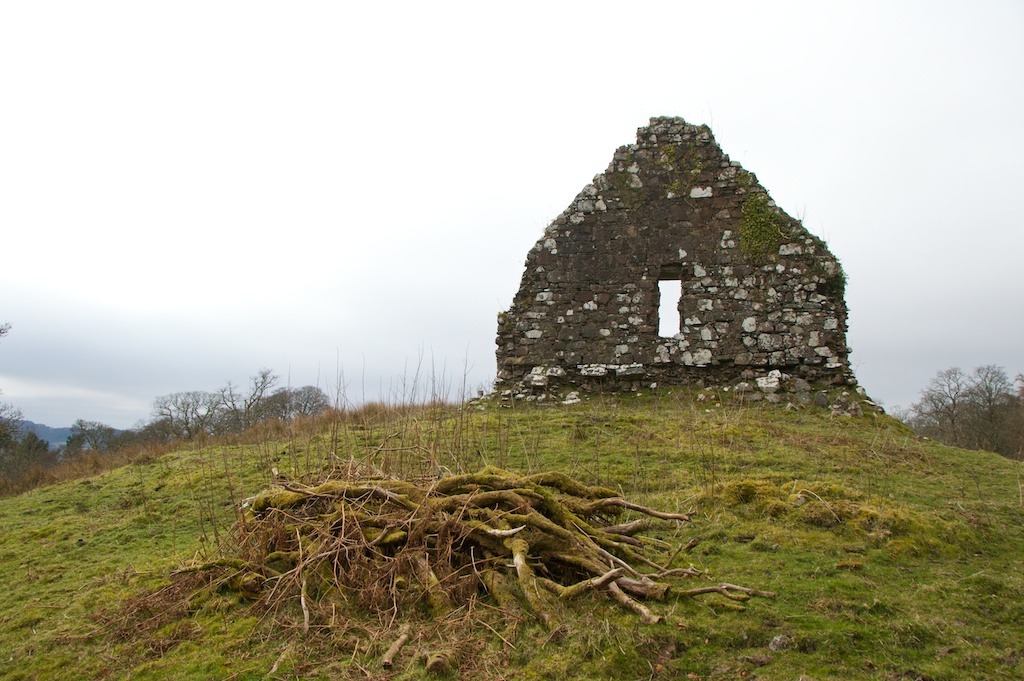
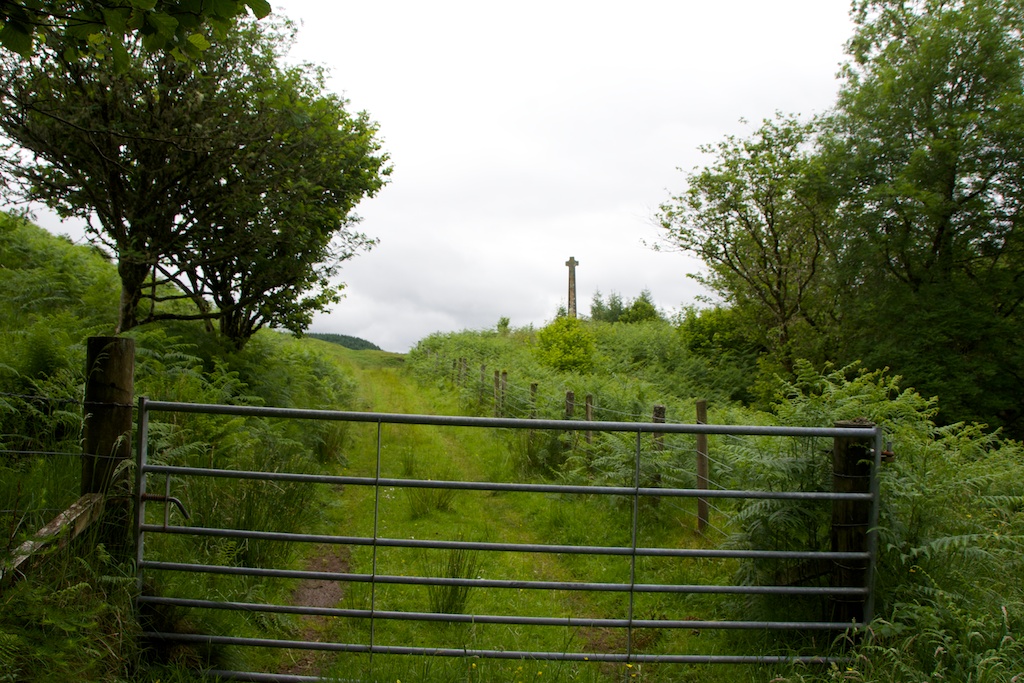
15 Comments
Deb Vallance
What a a wonderful, evocative description of your adventure! Thank you for your writing and for the stunning pictures.
Jo Woolf
That’s really kind, thank you Deb! It was one of those days when we were in exactly the right place at the right time, and it couldn’t have been more perfect.
Stravaiging around Scotland
Happy birthday!
Jo Woolf
Thank you! 😊
Finola Finlay
I so agree about January light – in fact my post tomorrow is about exactly that. I am always so struck by the similarities – you could have been on a day out in West Cork, with a stone circle and a tower house to see. Except for the deer, maybe.
Jo Woolf
I’m always struck by the similarities too, I think we’d feel right at home in Cork! Will look forward to your post.
Finola Finlay
And – Happy Birthday!
Jo Woolf
Thank you, Finola! 😊
Bob Hay.
A very interesting and productive short winter’s day* Jo. Colin’s photos are brilliant for capturing ambience and match up perfectly with your texts. I have to say, two artistic souls in unison.
Look at the perfectly straight corners of that masonry. Incredible in such an isolated location.
*It was 41 C here yesterday, lucky you.
Jo Woolf
It was a wonderful day. Thanks for your comments, Bob! They certainly knew how to build castles that last. I think most of the stone was quarried locally, at Laggan, and some from Carsaig to the south west. Don’t really envy you your 41 degrees although there’s a bitter north wind at present. Re. the index, it’s complicated! I’ve looked several times at how I could create an index. There’s nothing to suit what I’d want. Also, an auto index of the titles of my blog posts wouldn’t necessarily work. The only thing I can do (which I’ve been doing for a while) is to put them in categories, i.e. Scottish castles, megalithic sites. Pretty broad, but better than nothing. There’s a drop-down menu on the right sidebar.
Bob Hay
Thanks Jo. I was hoping you’d already done the heavy lifting for your own records to save me having to look up every article you’d done and organise them into categories
I’ll have to do some work by the look of it. So much to do, so little time.😩
Jo Woolf
Argh! If I hit on a solution I’ll let you know!
Bob Hay.
Meant to ask Jo, do you have an index of your articles and if so could I have a copy as I wan to start a folder for them.
darin pierce
What a stunning article. You should save this for the greatest hits.
Jo Woolf
Aw that’s so nice, thank you!